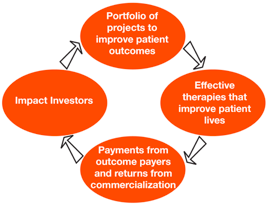Mission:Cure aims to demonstrate a new model for curing disease that provides financial incentivizes for improving patient outcomes and brings in resources from investors who want to make a social impact.
How Will Patient Outcome Financing Work?
Outcome Payers
Agree to pay for specific patient outcomes over an agreed period of time
Impact Investors
Fund therapeutic projects based on potential for improved patient outcomes and financial returns
Researchers and Life Sciences Companies
Develop therapies demonstrated to improve patient outcomes
Patients
Improve through new therapies, leading to payments from outcome payers and returns from commercial products
What is outcome financing?
Around the world, governments, foundations, and other payers are shifting the way they pay for important services. They are beginning to pay for outcomes—like better educated children, housing homeless people in stable residences, reductions in crime, and decreases in child abuse and neglect. Organizations that believe they can achieve those outcomes raise money to expand their services. Often this financing comes from “impact investors,” people who want their money to produce a positive social impact and also receive financial returns.
These financing arrangements are called “pay for success” programs, “social impact bonds,” “development impact bonds,” or “impact bonds.”
Over 17 of these projects have been implemented in the US. Worldwide, there are over 60 outcome financing projects, mobilizing over $200 million to improve health, education, the environment, and wellbeing.
More on outcome financing is available here:
How can outcome financing help people suffering from diseases?
Currently, investors, pharmaceutical companies, and, to a lesser extent, philanthropies and governments provide the funding needed to develop therapies for diseases. Too often, there is not enough funding to test promising ideas and bring them to market. This funding gap even has a name—“the valley of death.”
What if, in addition to the market incentives, there were a financial incentive for improving outcomes of people suffering from a particular disease in a specific timeframe? We believe this type of funding could bring new capital—and attention—from impact investors and catalyze stakeholders to work together to find the most efficient way to make the biggest difference for the most patients.
Adding payments based on patient outcomes to existing market incentives for pharmaceutical development addresses several limitations of our current drug development system. It incentivizes therapies based on how likely they are to make patients better, not on how profitable they are likely to be. It incentivizes strategies that reduce healthcare costs. It also prioritizes and creates accountability for making patients feel better and live longer.
We call this “Patient Outcome Financing.”
What do we mean by patient outcomes?
What if we incentivized the things people suffering from disease really care about? Examples include:
- the number of times they go to the emergency room or are hospitalized
- how often and severely they experience pain
- how long they live with their disease (survival rates)
- the number of days they miss work or school because of their illness
While we firmly believe everyone wants the best for patients, the things that patients care most about are not always measured or incentivized in our current health system. Tying funding to patient outcomes will incentivize researchers, providers, payers, funders, and biotech companies to work together to make a measurable difference for patients.
How will we measure patient outcomes?
For each project, Mission: Cure works with investors, outcome payers, and these institutions to choose one or more outcomes that are meaningful to patients and that can be feasibly measured and tracked. We partner with the institutions that collect and store the data to develop legal and practical ways to obtain it if patients consent to sharing the information.
Who are the potential payers?
Venture philanthropists. Philanthropists are exploring new ways to cure disease. Venture philanthropists who pay for patient outcomes will engage in what amounts to risk-free outcome-based philanthropy; they will not pay unless the efforts they support have delivered results for patients and families. Their funds will leverage the resources of impact investors to help people in measurable ways.
Healthcare payers. Currently, when someone suffers from a debilitating, unsolved disease, healthcare payers pay for medical care, hospitalizations, tests, and medications. By paying for improved patient outcomes, payers can incentivize development of therapies and preventive measures that would reduce their long-term costs.
Large employers. 80% of employers with more than 500 employees self-insure. Self-insured employers stand to benefit in at least two ways if their employees and their families can be effectively treated rather than suffering from a debilitating disease: they can reduce their healthcare costs and improve employees’ productivity.
Medicaid. As one of the largest healthcare payers, Medicaid covers large numbers of people who suffer from chronic diseases. Paying for improved patient outcomes could reduce costs and improve health.
The Veterans Administration. The VA, as a single-payer healthcare system, is well positioned to test innovative approaches to improve health outcomes while reducing costs.
Governments focused on improving health outcomes. Regardless of cost savings, many federal and state governments (and some local governments) prioritize improving health enough to devote taxpayer dollars to addressing residents’ health problems. Contracting for improved outcomes can be a low-risk way to use tax revenues to buy better health.
